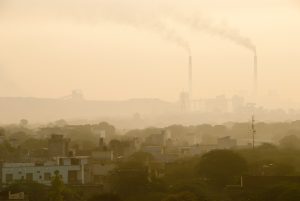Delivering the absentee Indian prime minister’s message at the Shanghai Cooperation Organization (SCO) meeting in Kazakh capital Astana on July 4, the country’s External Affairs Minister S. Jaishankar sought to bring focus to climate change, which he described as a “prominent concern.” He said that India is working toward achieving a committed reduction in emissions and building climate-resilient infrastructure.
In recent years, climate change has prominently figured in the speeches of Indian leaders at global forums. The apparent intention is to keep a constant focus on this existential challenge to mankind and also to highlight India’s commitment to fulfilling its objectives in adaptation and mitigation goals.
Behind such public statements, which have been loosely interpreted as India’s yearning to assume a leadership role in the Global South in regard to climate conversations, however, is a deep concern that climate change could mar the government’s economic goals.
This summer, northern India endured record-high temperatures. Parts of the national capital, Delhi, reached 52.3 degrees Celsius (126.14 degrees Fahrenheit). Energy demands soared to 8,302 megawatts (MW), mostly to run air conditioners. Renewable sources – solar and wind – contribute approximately 2,000 MW; the rest of Indian’s energy is generated from fossil fuel-driven plants.
Even the night temperatures in Delhi remained unbearably high. The poor working class in informal sectors such as cycle rickshaws and vendors, on whom the middle and upper classes depend for their daily needs and errands, found themselves devoid of work and drained of energy. The Reserve Bank of India’s Department of Economic and Policy Research (DEPR) stated in its 2022-23 report on currency and finance that up to 4.5 percent of India’s GDP could be at risk by 2030 due to lost labor hours from climate change issues, including extreme heat and humidity.
While the government of a country of 1.4 billion people chose to overlook the phenomenon of extreme heat that lasts for only a quarter of a year and just in some parts of the country, the more serious impact of climate change on the country’s economic aspiration may have begun to figure on the government’s agenda, or at least in its public pronouncements. The current government’s goal of making India a developed country by 2047 is critically linked to building more resilient and reliable supply chains, diversifying centers of production and de-risking the global economy, to the extent possible.
According to a study by the University College London Bartlett School of Sustainable Construction, published in March 2024, supply chain disruptions due to climate change could cause a projected net economic loss of between $3.75-24.7 trillion by 2060. India, in particular, due to close links with countries severely impacted by heat stress, is likely to be significantly affected. For instance, Indonesia and Malaysia – from where India sources raw material such as palm oil – are among those most affected by climate change. The entire value chain of India’s food sector contributes 13 percent of its GDP and the impact could be hugely disruptive.
Memories of supply chain disruption during the COVID-19 pandemic are still fresh in the Indian official psyche. Those disruptions significantly impacted India’s manufacturing, health, food supply, and retail sectors. India’s vulnerability due to its heavy dependence on imported fuel and a large merchandise trade deficit was fully exposed. While full recovery is yet to be made, India wishes to avoid a repeat of the same scenario, as far as possible.
Not surprisingly, therefore, Jaishankar, during the G-20 Development Ministers’ conclave in June 2023 in Varanasi, proposed a seven-year action plan for a united global approach to deal with slow-paced economic recovery affected by supply chain disruptions, prolonged debt crisis, and pressures in energy, food, and fertilizer security. He touched upon the same theme at a conference in Perth in February 2024, calling for dispersed production and building resilient and reliable supply chains. The latest statement in Astana is an expression of India’s continued concern.
Achieving this, however, is linked to a range of factors including united global action, meeting commitments on funding and technology transfer from the developed world, and also domestic action in both adaptation and mitigation strategies. In all three realms, efforts are falling short. Beyond the rhetoric, there is a need to develop a well-coordinated and multistakeholder cooperative strategy from the local to the global level to achieve tangible climate change outcomes.

































